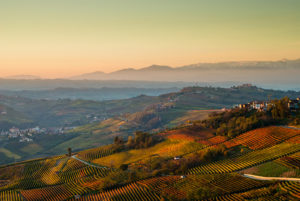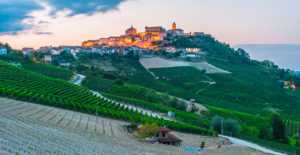Autumn has arrived and with it come shorter days, cooler temperatures, and of course, the holidays. A wonderfully festive season, autumn is a time to break out cozy sweaters and savor the awesome beauty of the great outdoors, spend time with cherished family and friends, and share festive meals and wine. On Thanksgiving, we celebrate our nearest and dearest. Why not make the day even more special with a memorable wine?
As the weather grows colder, we tend to gravitate towards heavier, more substantial wines. While cabernet sauvignon and merlot enjoy great popularity, it may be time to try something new and different.
Nebbiolo, an aromatic grape hailing from the Piedmont region of northern Italy at the foot of the Italian Alps, produces outstanding wines celebrated the world over. Named for the Italian word for fog or “nebbia,” as the region tends to be quite chilly and foggy much of the year, Nebbiolo is the grape used to craft the legendary wines of Barolo and Barbaresco.
The Italians call Barolo, “The King of Wines,” and for good reason. The wines are intense and powerful and can age for decades. Barolo is produced within the boundaries of a series of towns, including the town of Barolo itself. A wine can only be called a Barolo if it is produced within the boundaries of those towns. Each town’s wine has its own special attributes that make it unique and different to all the others. For instance, if you prefer a heavy tannic red wine, you might choose a Barolo from the town of Castiglione Falletto. If you prefer a Barolo with softer tannins seek out a wine from the town of La Morra.
If Barolo is the king of wines, then surely Barbaresco is the queen. Barbaresco is also made from the nebbiolo grape and produced just ten miles from Barolo in another demarcated zone. Barbaresco wines tend to be slightly fruitier, more perfumed, and more feminine in nature.
While both are wines of great power and beauty, Barbaresco is considered gentler while Barolo is more hearty and tannic. If looking for a passionate literary comparison, perhaps a Barolo would be Henry Miller and a Barbaresco, Anais Nin.
Both Barolo and Barbaresco are pale garnet in color and have a spicy floral quality on the nose, with plenty of earthy minerality. On the palate, the wines are very high in acid. Flavors can include strawberries, cherries, rose petals, black tea leaves, and even tar. Depending on the producer and the vintage, the wines might also offer aromas of vanilla, toast, cinnamon, and clove.
A young Barolo or Barbaresco can often be too intense to consume pleasurably. Aging allows the wines to improve. The flavors soften and gain in complexity. Layers of spice are added and the wines become more perfumed. A bottle of aged Barolo or Barbaresco adds instant elegance to any holiday table. Not cheap wines, Barolo and Barbaresco may range in price from $20 to many hundreds of dollars.
Nebbiolo wine without the fancy Barolo/Barbaresco moniker is made in other parts of northern Italy as well. If Barolo and Barbaresco are not in your budget, seek out a Langhe Nebbiolo. Produced just outside the Barolo and Barbaresco regions, Langhe Nebbiolo’s can be extraordinarily delicious at a fraction of the price of their more famous cousins.
Many excellent nebbiolo wines are crafted all over the world, including Australia and California. The Sierra Foothills AVA is home to several wineries producing wonderful nebbiolo wines worth seeking out. Delicious with a variety of cheeses as well as wild game, rich pastas, and roasted meats, nebbiolo is a true food-lover’s wine. Try it this year with your Thanksgiving dinner. It’s sure to become a lasting tradition.
pastas, and roasted meats, nebbiolo is a true food-lover’s wine. Try it this year with your Thanksgiving dinner. It’s sure to become a lasting tradition.
Cheers!
Leave a Reply